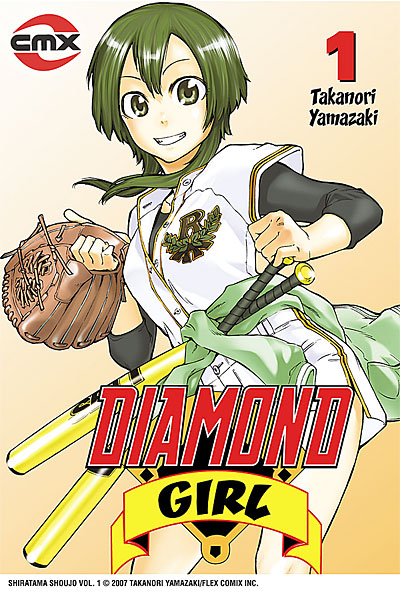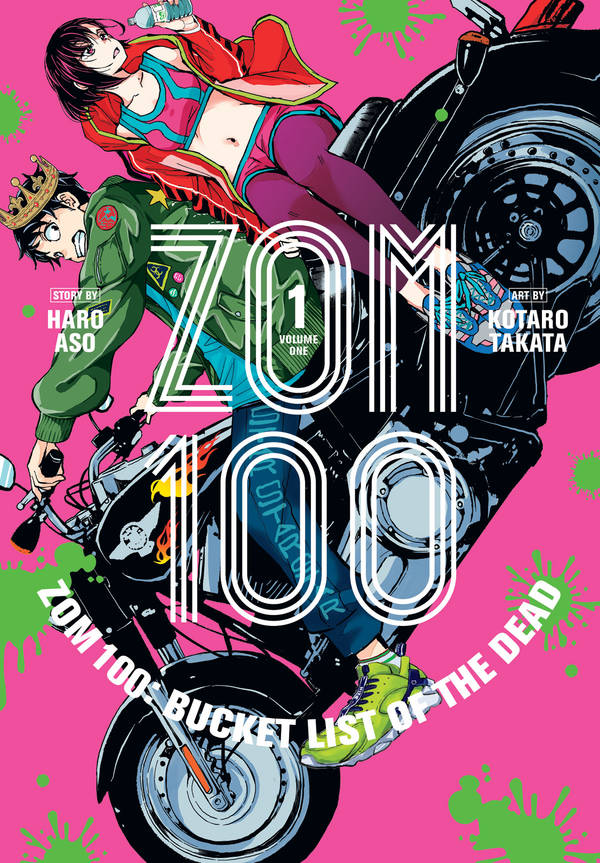Part Bad News Bears, part Boys of Summer, Diamond Girl follows a time-honored sports-comedy formula in which a team of losers have their pennant dreams rekindled after an unlikely but undeniable talent joins their ranks. In Diamond Girl, those hard-luck athletes are Baba, Seto, and Takagi, the heart and soul of the Ryukafuchi High School baseball club. The trio discovers, by accident, that the new transfer student has the throwing arm of a youthful Roger Clemens, capable of nailing a moving object hundreds of feet away or throwing a shotput with the ease and precision of a softball. The catch: Tsubara is a girl, making her ineligible to play.
Actually, there’s another obstacle to Tsubara joining the team: she doesn’t want to. At first, Tsubara vehemently denies her skills, feigning bewilderment at her ability to snatch a line drive from the air, bare-handed. When Tsubara’s classmates remain unpersuaded, Tsubara finally concedes her athletic prowess, but rebuffs Baba and Takagi’s suggestion that she play baseball in drag. (“We hide her chest by wrapping it up in bandages,” Takagi confidently asserts. “I see no problem.”) How Tsubara came by her skills, and why she refuses to play, are the central mysteries of volume one, and provide most of the series’ comedic — and dramatic — juice.
Anyone expecting a baseball version of Crimson Hero will be in for a rude shock with Diamond Girl. There’s fan service a-plenty, from a “whoops, I didn’t mean to collide with your chest!” gag to a bath scene that seems calculated to reassure readers that Tsubara is 100% girl, even if she could beat the snot out of her teammates, on or off the field. (The author annotates one panel with the cheerful admission that “Today, we bring you more fan service than usual.”) Aside from a truly distasteful scene in which the team pervert assesses Tsubara’s panty preferences — he bemoans her tendency to wear “little kid underpants” — the fan service is easy enough to overlook, even for an old feminist curmudgeon like me.
The real joy of Diamond Girl is watching Tsubara lose herself in the moment. Midway through volume one, for example, a monkey steals Tsubara’s treasured purse, ripping it open and fleeing to the safety of the school roof to examine its contents. Tsubara doesn’t hesitate; she transforms herself into a human pitching machine, lobbing balls and rocks at the culprit until one well-timed throw knocks the purse of the monkey’s hands. A similar sense of joyful abandon informs a scene in which Tsubara plays fetch with her dog Hachi, who shares his mistress’s talent for fielding extreme fly balls — as well as her ability to tune out her surroundings. (He crash-lands on top of Tsubara’s classmate, ball in mouth.) Tsubara runs their game with the intensity of a drill sargeant or big league coach, treating Hachi as if he’s a star right fielder.
Manga-ka Takanori Yamazaki demonstrates a genuine knack for caricature, neatly encapsulating each character’s personality in a few gestures: a mohawk for the slightly chubby, irreverent Takagi; a row of earrings and a maniacal gleam for the more energetic Baba; a pair of ratty pigtails and a scowl for Tsubara. Though Yamazaki makes a game effort to immerse us in the action, his fondness for dramatic camera angles and freeze-frames occasionally results in an awkwardly composed drawing; in more than one scene, he foreshortens characters to such a degree that they look a bit squashed. Yamazaki also relies on tracing just a little too often, as the monkey scene attests; all of the monkeys have a straight-off-the-lightbox quality that suggests a National Geographic spread on the hot-tubbing macaque of Honshu. Even with such obvious limitations, however, the artwork suits the story’s broad comedic tone without becoming too frantic.
If the one-note characters and suggestive situations prevent Diamond Girl from scoring a homerun, it’s certainly a solid base hit, offering an enjoyable mixture of game play and humor that should appeal to baseball enthusiasts, manga lovers, and female athletes of all stripes. Recommended.
DIAMOND GIRL, VOL. 1 • BY TAKANORI YAMAZAKI • CMX MANGA • RATING: TEEN (13+) • 160 pp.




Jade says:
I haven’t been able to give this a solid read since I’ve been pre-occupied with Yotsuba and Bunny Drop (picked up on your reccomendation), but from what little I’ve read, a lot of the fan service seemed more like an extension of Tsubara’s shameless, or rather shame-free, personality and seems somewhat within her purview. The pantie scene may be distasteful more for taking that power of…incidental sexuality out of Tsubara’s hands. It’s no longer Tsubasa’s free expression, but a pervert’s indiscretion.
Maybe I just read too much into fan service though, haha!
Jade says:
Ok, I finished reading it and confirmed some of my early impressions.
The fan servicey bits, which really aren’t too risque, do seem to suggest sort of a free and proud spirit in Tsubura, I think. When she throws that first pitch from the classroom, she loses herself in the moment and the curves of her uniform and skirt form graceful contours to her body in motion. Suddenly, she regains her composure and we think she’s thinking, ‘Oh no, the whole class saw up my skirt!’ but no, she’s upset they saw her pitch a baseball.
Overall, I think her wayward skirt is a great metaphor for the overall story: Tsubura feels a natural freedom in baseball that goes against the grain of social standards like the proper positioning of a skirt. Everyone around her but Granny just tries to twist that natural love and feminine freedom to their own ambition and gratification as paralleled in the scene where the pervert flips up her skirt.
Another goofy observation, but in the team players so far, I noticed: Yasaka-Lust, Takagi-Pride, Baba-Wrath, Adachi-Avarice, Seto-Gluttony/Sloth?…do you think there’s a real connection there? The characterisations seemed fairly specific along those lines, but it doesn’t quite line up with nine players + manager Adachi.
Katherine Dacey says:
You’re right about the fan service, Jade: on a scale of one to ten, it rates about a three. I’ve certainly seen a lot worse, and agree that in many instances it actually serves a dramatic purpose. Some of it was just too blatant or cheesy for me, however: Tsubara colliding with another female character’s breasts, Tsubara’s pervy classmate pulling up her skirt to inspect her underwear. But your observations about the fan service are well-taken; no one will confuse Diamond Girl with Rosario + Vampire or Ral Grad anytime soon!
As for the names… I have a confession to make: I don’t know Japanese. Given the story’s cheeky, broad tone, however, it seems par for the course that the supporting players would have such terrifically suggestive names. What does “Tsubara” mean — is it the equivalent of “Xena, Warrior Princess” in Japanese?
Jade says:
Oh, no, sorry Kate, I was just connecting the characters to what I thought really stuck out as their majorly defining trait. My knowledge of Japanese only covers enough to make me look stupid were I to claim any knowledge of it. But…the team manager, for instance, seems a bit awkward for a school friend stand-by taken at face value, but avarice really seems to sum her up perfectly. The Deadly Sins really seem to fit the characterisations fairly well, but it’s hard to say if they’re a direct influence. They could be inspired by the Seven Dwarves, which were themselves inspired by the Sins, in a multi-cultural dogpile and that might actually make more sense assuming Tsubura as Snow White?